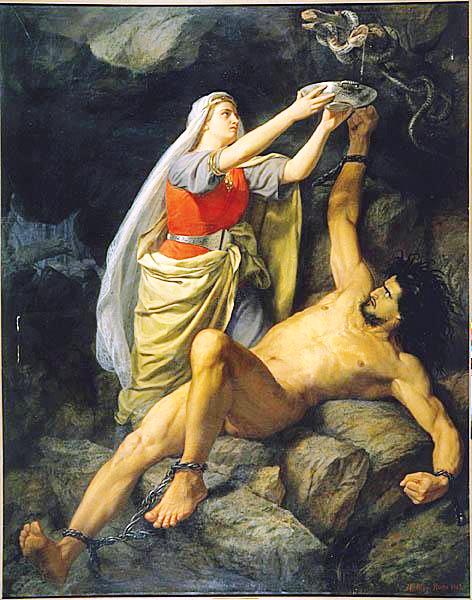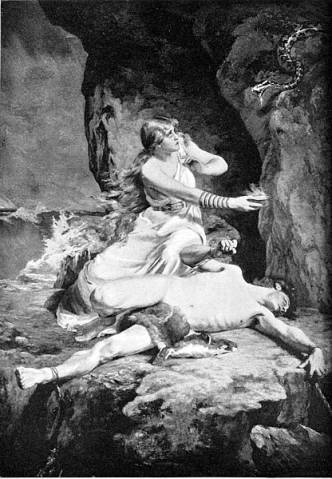Sigyn is the Aesir goddess of compassion and devotion, who is also the wife of Loki. In the end, when Loki is justly punished for his many misdeeds, Sigyn never leaves his side. She also had to endure losing her son to the gods in their revenge for the death of Balder. Standing by Loki through millennia, she was the symbol of devotion and sadness.
Sigyn’s Origins – Possibly Odin’s Daughter
I have found a few dubious claims about who Sigyn’s parents are. However, the fact is that we do not know for sure who the parents of Sigyn are. There are no mentions of her origins anywhere in the old Norse texts. She is listed among the asynjur, the Aesir goddesses, so we know she belongs to the Aesir.
In the greater story of Norse mythology it is obvious she had parents. That part of her story is now lost to us though. Still, her name might actually hold a clue as to who her father was.
In a fragmentary anonymous poem listing kennings for Odin, one is Sigfǫðr. This literally means Father of Victory/Battle, as ‘Sig’ is from sigr, meaning victory, and fǫðr means father. However, Sigyn’s very name might be the clue here. Sigyn is also derived from sigr, combined with -yn, which is a version of –vin, meaning friend.
So, Odin’s name Sigfǫðr, could in fact instead be Father of Sigyn. Lending this argument more weight is the fact that Odin and Loki are actually sworn blood brothers. Loki being married to Odin’s daughter makes sense in that perspective.
Sigyns Role in Norse Mythology
Sigyn’s story is one of great loss and sacrifice, as well as one of lasting devotion to her imprisoned husband. She isn’t mentioned often in the old manuscripts. The only time a description is made of Sigyn, she is said to be sad.
In the world of the Vikings, I do believe that Sigyn would have been an example of devotion and loyalty. Even when that loyalty and devotion was tested for all eternity, she didn’t leave her husband’s side.
Narfi – Son of Sigyn and Loki
While Loki had several other children with the jötun Angrboda, he only had one son with Sigyn. His name was Narfi, and he is only ever mentioned in context of Loki’s punishment and imprisonment.
Snorri Sturluson, in his Prose Edda, actually claimed that Sigyn and Loki had two children. According to him, they had Narfi, but also a second son named Vali. This is clearly some unknowing, or deliberate mistake on Snorri’s part, as Vali was the son of Odin, and the god of retribution.

The Punishment of Loki
The fate of both Sigyn and Narfi is sealed when Loki manipulates Hodr into killing the god Balder. Beloved by all, Balders’ death is a shock to the Aesir gods, and their lust for revenge knows no bounds.
Caught in the middle between Loki and the gods lashing out at him, are the quite innocent Sigyn and Narfi. When the gods catch up with Loki, after the death of Balder, they bring him to a cave.
There Vali, son of Odin, born to avenge the death of Balder, literally the instrument of the gods revenge, turns into a wolf and rips Narfi to pieces. To the Christian Snorri, this might have seemed like a punishment to Vali as well. However, it really only shows how Vali is an Ulfhedin, able to shape-shift and take on the shape and powers of the wolf.
Using Narfi’s intestines, they tie Loki down. Then over his head, the goddess Skadi places a venomous snake so that its poison drips into Loki’s eyes.
Sigyn, having lost her son and with her husband Loki bound to a rock, willingly stays by his side. There she holds a bowl, (or a seashell depending on the source) catching the dripping poison. However, when the vessel is full, she has to go outside to throw it out. As she leaves Loki’s side, the poison drips into his eyes, causing so much pain that his thrashing about makes the ground shake. This conveniently also explains what causes earthquakes to the Vikings.
Mentions of Sigyn in the old texts
As I said before, Sigyn really isn’t mentioned often. She is not the focus of any of her own stories, and we never learn anything about her background. Instead, her most prominent mentions are in regards to the fate of Loki.
In Snorri’s Prose Edda, she is mentioned in both the Gylfaginning and the Skaldskaparmal. It’s in the Gylfaginning that we learn about the punishment of Loki, and how Sigyn stays by his side throughout all time. Then in Skaldskaparmal she is mentioned twice, first in a list of the goddesses attending the feast at Aegir’s hall, then in the Nafnathulur section, in a list of all the goddesses.
Having referred to Snorri’s work as a source I feel I have to remind the reader that he wrote his Prose Edda almost two hundred years after the end of the Viking Age. He surely had access to several sources of information, but he did make some mistakes, like that of who Vali really was, and he is seen as a less reliable source.
Mentions in the Poetic Edda
The more reliable, and older sources are the collection of poems known as the Poetic Edda. There Sigyn is mentioned twice, once in the Lokasenna, and once in the Voluspá. The Voluspá verses are rather short and likely relied on the listener knowing the source material well already. Verse 35 goes like this:
35. One did I see | in the wet woods bound,
A lover of ill, | and to Loki like;
By his side does Sigyn | sit, nor is glad
To see her mate: | would you know yet more?
This obviously refers to Loki having been bound, and Sigyn is sitting by his side. Her being sad could be just because of his situation, but might as well be because of their shared circumstances, and the loss of their son.
In the Lokasenna, Sigyn is also mentioned in the context of Loki’s punishment, again, sitting by his side, catching the poison from dripping into his eyes.

Final Thoughts on Sigyn
We are obviously missing large parts of Sigyn’s story. Was she really the daughter of Odin, and if so, who was her mother? How, and when did she come to be married to Loki?
One thing I do feel is certain. While not known to us today, her origins and background would have been known to the Vikings. She was one of their goddesses, and a symbol of devotion and sacrifice, surely they knew where she came from.
The fact that she doesn’t leave Loki’s side also plays into the Vikings somewhat fatalistic beliefs. Your fate was decided by the Norns at the time of your birth, and that went for both humans and gods. Sigyn’s ultimate fate was to sit by her husband’s side, aiding him in his misery. In doing so, Sigyn probably served as a great example of a woman’s devotion and loyalty to her husband.
Play Fun Norse Quiz
Is this article making you even more curious about Norse gods and goddesses? You can satisfy your curiosity by playing a fun Norse mythology quiz. This way, you can test your knowledge about Norse gods and goddesses, as well as fill in some gaps. Good luck and have fun playing!
Don’t forget to try our other games as well!
FAQs
The answer is love. Sigyn must be deeply in love with Loki to be so devoted to him. Unfortunately, the details of how these two met are not available. But, her selflessness and faithfulness signify her unconditional love towards the god of mischief.
The Aesir wanted to punish Loki for killing their beloved Baldur. The idea of just imprisoning him wasn’t enough. So, they mercilessly killed his sons he had with Sigyn in order to make him hurt. The notion behind this decision is clear enough. But, the pain inflicted on her is beyond measure. Someone might say that she had to know the price of marrying such a wicked and dangerous god.
Featured Image Credit: Christoffer Wilhelm Eckersberg, Public domain, via Wikimedia Commons

She is also mentioned in Jakub Ćwiek book, Liar in first tome
Hi Karolina, thanks for the recommenddation. Gotta say that book, “Loki – the Liar: Heaven’s Hitman” is pretty cool 🙂